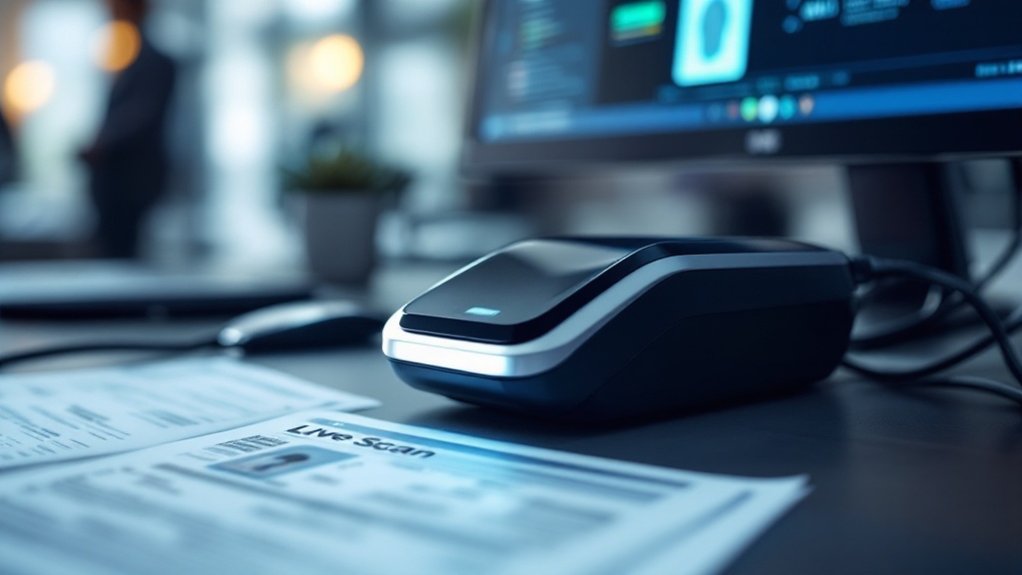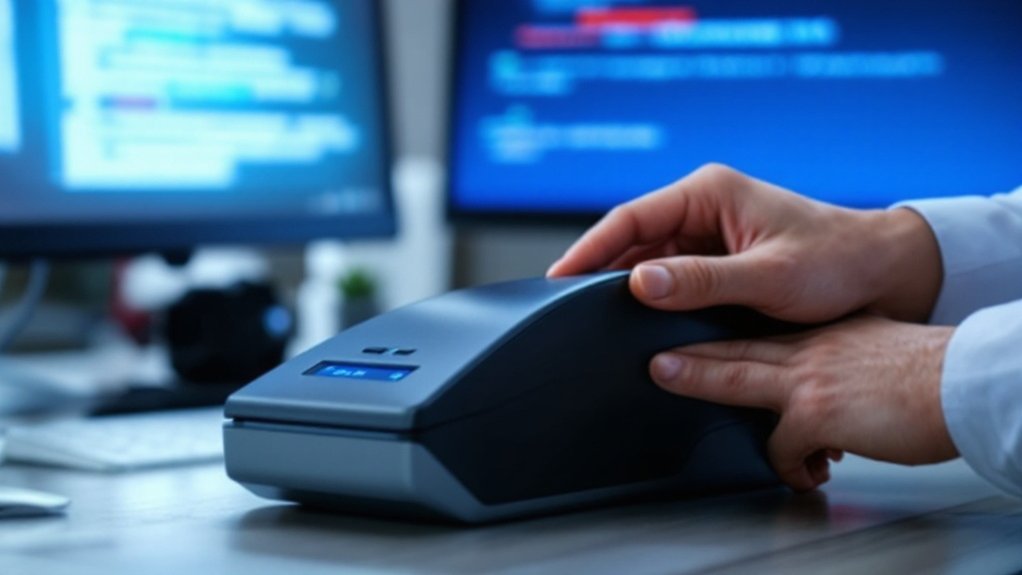You’ll use live scan fingerprinting software by setting up a system with an Appendix F certified scanner and an FBI-certified computer. Guarantee your workspace accommodates both you and the client. The software guides fingerprint capture, performing real-time quality checks. It securely transmits data to agencies like the FBI. You’ll manage biometric records and assure compliance with regulations. As you continue, you’ll explore more detailed steps and best practices for optimizing your workflow.
Setting Up the Live Scan System

To set up a live scan fingerprinting system, you’ll need to carefully consider both the physical environment and the technical requirements. Guarantee your workspace has a table or surface about 15-20 inches below the client’s shoulder for comfortable fingerprinting. The desk should accommodate a monitor, keyboard, and a 6″ x 7″ scanner. Both you and the client should be able to stand side-by-side.
For technical setup, use a ten-print fingerprint scanner that is Appendix F certified by the FBI. Your computer must meet the vendor’s system requirements, and the printer must be FBI-certified with the software. Verify all equipment is compatible and certified to maintain compliance. Starting a live scan business typically requires an initial investment in the range of $4,000 to $6,000 for the necessary equipment and software, which can be covered through bank loans.
Capturing Fingerprints With Live Scan Software
Once you’ve set up your live scan system, you’re ready to capture fingerprints using the live scan software. This process involves electronically capturing both flat and rolled fingerprints, including thumbs and four-finger slaps from each hand, using a digital scanner. The software guides you through the capture process, guaranteeing high-quality images with real-time quality checks. Trained operators assist to verify accurate data collection.
As you capture fingerprints, the software helps troubleshoot issues like incomplete prints or misaligned fingers. Features like auto-center and auto-contrast enhance image quality. Once captured, the fingerprints are securely transmitted to designated agencies, such as the FBI or state repositories. This efficient process streamlines background checks and identity verification. The live scan technology ensures that the digital format can be stored and transmitted to related authorities, utilizing FBI-certified scanners for high-quality image capture.
Ensuring Data Quality and Transmission

Guaranteeing the quality and secure transmission of fingerprint data is indispensable when using live scan software. You’ll want to focus on real-time image analysis, which checks for quality and compliance before capturing the final image. This process includes fingerprint segmentation and quality scoring to ensure high-quality images, especially for FBI-compliant records.
To optimize data transmission, you’ll use electronic methods to securely send data to law enforcement agencies. This involves adhering to FBI standards and using secure protocols like WSQ compression. Preserving system integrity through device abstraction and regular software updates is also imperative. Additionally, features like liveness detection and data encryption enhance security by protecting transmitted data and ensuring it comes from a live source. Utilizing a common API, such as the LiveScan API, allows for seamless integration with various fingerprint capture devices, ensuring consistent data quality across different hardware setups.
Managing Biometric Records and Compliance
As you manage biometric records, it’s pivotal to implement robust record management practices that guarantee data integrity and compliance with regulations like GDPR and BIPA. You’ll need to conduct regular compliance checks to verify that your processes align with legal requirements, such as obtaining explicit consent and maintaining secure data storage. By focusing on these aspects, you can effectively handle biometric data while minimizing risks and ensuring transparency in data use. Additionally, incorporating regulatory compliance measures helps ensure accountability and oversight in managing sensitive biometric information.
Record Management
Managing biometric records effectively is essential for maintaining the integrity and security of identity verification systems. Centralized databases, like those in Biometric Identity Management Systems (BIMS), guarantee real-time access and updates across sites, combining fingerprint, iris, and face recognition for inclusive management. These systems protect biometric data to prevent loss or misuse, reducing identity fraud.
You can leverage browser-based platforms for streamlined biometric enrollment and data management. Live Scan fingerprinting enhances accuracy and efficiency by capturing fingerprints electronically and transmitting data securely. Software platforms like IXM WEB manage biometric devices and employee data centrally, offering advanced security features to safeguard sensitive information. Effective biometric enrollment involves collecting and storing biometric templates securely, which is crucial for ensuring the uniqueness of each individual’s identity in the database.
Compliance Checks
When implementing Live Scan fingerprinting, how do you guarantee that your processes comply with the complex regulatory landscape? You must adhere to federal and state regulations, affirming your systems meet standards for capturing and transmitting biometric data. This includes using encrypted software to secure data and obtaining certifications from agencies like the FBI. To manage biometric records effectively, you’ll need to store data securely, control access strictly, and follow retention policies. Regular audits and inspections help maintain compliance. Additionally, verify that your systems perform real-time quality checks and use liveness detection to enhance security. This approach confirms data integrity and compliance with federal regulations, such as TSA and FBI standards. Ensuring compliance also involves ensuring that the captured fingerprints are interoperable with law enforcement systems, such as those using Live Scan technology, to facilitate efficient background checks.
Troubleshooting Common Issues in Live Scan

Troubleshooting common issues in Live Scan fingerprinting involves addressing both technical and procedural challenges. You’ll need to tackle problems like poor print quality, incorrect annotations, and sequence errors. To improve print quality, focus on hydrating and moisturizing your skin before the scan.
- Proper Finger Placement: Guarantee fingers are placed correctly on the device.
- Regular Maintenance: Clean the platen regularly to prevent ghost images.
- Operator Training: Verify operators are certified to handle the device accurately. Ensuring that the Live Scan process is efficient requires understanding that it is a digital fingerprinting process, which captures fingerprints electronically, eliminating traditional ink-based methods.
Optimizing Live Scan Workflows for Efficiency**
As you optimize live scan workflows, you’ll focus on streamlining operations and enhancing efficiency. You can achieve this by implementing advanced algorithms for better fingerprint quality, utilizing mobile solutions for remote data capture, and integrating multi-modal biometrics for increased accuracy. By employing user-friendly interfaces and ensuring robust data security, you’ll reduce errors and safeguard sensitive information, making your live scan processes more reliable and efficient. Additionally, incorporating machine learning techniques can further enhance the accuracy of fingerprint recognition by effectively handling low-quality prints and partial fingerprints.
Streamline Operations
To streamline operations with live scan fingerprinting software, you can leverage advanced technology to optimize workflows for efficiency. This includes using machine learning and AI to enhance fingerprint image quality and match accuracy. Additionally, mobile solutions allow for remote fingerprinting, speeding up identification processes.
- Maintain Real-Time Quality Checks: Guarantee high-quality fingerprint images are captured before submission.
- Use Cloud-Based Storage: Boost data access and management efficiency.
- Deploy Portable Devices: Expand fingerprinting services beyond traditional settings. By integrating these technologies, you can vastly improve operational speed and accuracy.
Enhance Efficiency**
Enhancing efficiency in live scan fingerprinting involves leveraging cutting-edge technology to optimize workflows. You can achieve high accuracy and speed by using advanced algorithms that guarantee precise fingerprint capture and quick processing, reducing errors and rescans. Compliance with industry standards, such as FBI and DOJ requirements, safeguards alignment with national and state guidelines. A user-friendly interface allows technicians to operate efficiently, enhancing the customer experience. Secure data handling through encrypted storage and transmission protects sensitive information. By utilizing electronic submissions, the process eliminates the need for manual handling, further increasing efficiency and reducing potential errors.
Conclusion
As you master live scan fingerprinting software, imagine a seamless digital canvas where fingerprints are captured with precision and transmitted securely. Your expertise weaves together technology and compliance, ensuring high-quality biometric records. With each successful scan, you’re not just capturing prints—you’re building a bridge of trust between individuals and institutions, illuminating identities with clarity and speed.

